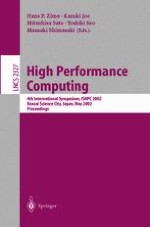
2002 | OriginalPaper | Buchkapitel
The Gilgamesh MIND Processor-in-Memory Architecture for Petaflops-Scale Computing
An Extended Abstract
verfasst von : Thomas Sterling
Erschienen in: High Performance Computing
Verlag: Springer Berlin Heidelberg
Enthalten in: Professional Book Archive
Aktivieren Sie unsere intelligente Suche, um passende Fachinhalte oder Patente zu finden.
Wählen Sie Textabschnitte aus um mit Künstlicher Intelligenz passenden Patente zu finden. powered by
Markieren Sie Textabschnitte, um KI-gestützt weitere passende Inhalte zu finden. powered by
Implicit in the evolution of current technology and high-end system evolution is the anticipated achievement of the implementation of computers capable of a peak performance of 1 Petaflops by the year 2010. This is consistent with both the semiconductor industry’s roadmap of basic device technology development and an extrapolation of the TOP-500 list of the world’s fastest computers according to the Linpack benchmark. But if contemporary experiences with today’s largest systems hold true for their descendents at the end of the decade, then they will be very expensive (> $100M), consume too much power (> 3 Mwatts), take up too much floor space (> 10,000 square feet), deliver very low efficiency (< 10%), and are too difficult to program. Also important is the likely degradation of reliability due to the multiplicative factors of MTBF and scale of components. Even if these systems do manage to drag the community to the edge of Petaflops, there is no basis of confidence to assume that they will provide the foundation for systems across the next decade that will transition across the trans-Petaflops performance regime. It has become increasingly clear that an alternative model of system architecture may be required for future generation high-end computers.